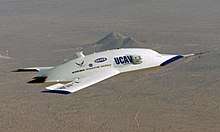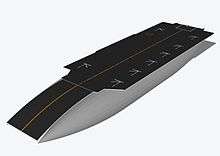Unmanned combat aerial vehicle
An unmanned combat aerial vehicle (UCAV), also known as a combat drone, is an unmanned aerial vehicle (UAV) that usually carries aircraft ordnance such as missiles, ATGMs, and/or bombs and is used for drone strikes.[1][2] These drones are usually under real-time human control, with varying levels of autonomy.[3]
Aircraft of this type have no onboard human pilot.[4] As the operator runs the vehicle from a remote terminal, equipment necessary for a human pilot is not needed, resulting in a lower weight and a smaller size than a manned aircraft. Many countries have operational domestic UCAVs and many more have imported armed drones or have development programs underway.[5]
History
One of the earliest explorations of the concept of the combat drone was by Lee De Forest, an early inventor of radio devices, and U. A. Sanabria, a TV engineer. They presented their idea in an article in a 1940 publication of Popular Mechanics.[6] The modern military drone as known today was the brainchild of John Stuart Foster Jr., a nuclear physicist and former head of the Lawrence Livermore National Laboratory (then called the Lawrence Radiation Laboratory).[7] In 1971, Foster was a model aeroplane hobbyist and had the idea this hobby could be applied to building weapons.[7] He drew up plans and by 1973 DARPA (Defense Advanced Research Projects Agency) built two prototypes called "Prairie" and "Calera". They were powered by a modified lawn-mower engine and could stay aloft for two hours while carrying a 28-pound (13 kg) load.[7]
In the 1973 Yom Kippur War, Israel used unarmed U.S. Ryan Firebee target drones to spur Egypt into firing its entire arsenal of anti-aircraft missiles. This mission was accomplished with no injuries to Israeli pilots, who soon exploited the depleted Egyptian defences. In the late 1970s and 80s, Israel developed the Scout and the Pioneer, which represented a shift toward the lighter, glider-type model of UAV in use today. Israel pioneered the use of unmanned aerial vehicles (UAVs) for real-time surveillance, electronic warfare, and decoys.[8][9][10] The images and radar decoying provided by these UAVs helped Israel to completely neutralize the Syrian air defences in Operation Mole Cricket 19 at the start of the 1982 Lebanon War, resulting in no pilots downed.[11]
In the late 1980s, Iran deployed a drone armed with six RPG-7 rounds in the Iran–Iraq War.[12]
Impressed by Israel's success, the US quickly acquired a number of UAVs, and its Hunter and Pioneer systems are direct derivatives of Israeli models. The first 'UAV war' was the first Gulf War: according to a May 1991 Department of the Navy report: "At least one UAV was airborne at all times during Desert Storm." After the Gulf War successfully demonstrated its utility, global militaries invested widely in the domestic development of combat UAVs.[13] The first "kill" by an American UAV was on October 7, 2001, in Kandahar.[14]
In recent years, the U.S. has increased its use of drone strikes against targets in foreign countries and elsewhere as part of the War on Terror. In January 2014, it was estimated that 2,400 people have died from U.S. drone strikes in five years.[15] In June 2015 the total death toll of U.S. drone strikes was estimated to exceed 6,000.[16]
Future models
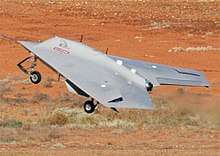

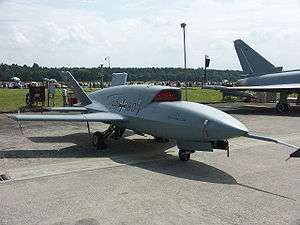
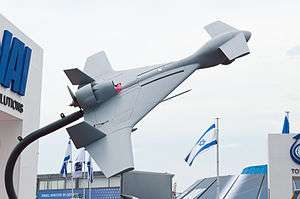
Overview
Note: Some of these are not aircraft prototypes but technology demonstrators (TD) that are not expected to enter service.
Various Chinese UCAV concepts have also materialized. WZ-2000, UCAV versions of the Xianglong high altitude are long endurance UAV. Also, dedicated UCAV's Shenyang's Dark Sword (Anjian), and also revealed at Zhuhai 2008 was a model of a stealth strike UCAV with forward swept wings, filling a similar niche to U.S. X-45 called the Warrior Eagle.
BAE Taranis
Taranis is a British demonstrator program for unmanned combat air vehicle (UCAV) technology. It is part of the UK's Strategic Unmanned Air Vehicle (Experimental) programme (SUAV[E]). BAE describes Taranis's role in this context as following: "This £124m four year programme is part of the UK Government's Strategic Unmanned Air Vehicle Experiment (SUAVE) and will result in a UCAV demonstrator with fully integrated autonomous systems and low observable features."
The Taranis demonstrator will have an MTOW (Maximum Takeoff Weight) of about 8000 kilograms and be of comparable size to the BAE Hawk – making it one of the world's largest UAVs. It will be stealthy, fast, and able to deploy a range of munitions over a number of targets, as well as being capable of defending itself against manned and other unmanned enemy aircraft. The first steel was cut in September 2007 and ground testing started in early 2009. The first flight of the Taranis took place in August 2013 in Woomera, Australia.[22] The demonstrator will have two internal weapons bays. With the inclusion of "full autonomy" the intention is thus for this platform to be able to "think for itself" for a large part of the mission.
J-UCAS
- Boeing X-45 UCAV (TD)
- Northrop-Grumman X-47 Pegasus
Joint Unmanned Combat Air Systems, or J-UCAS, was the name for the joint U.S. Navy/U.S. Air Force unmanned combat air vehicle procurement project. J-UCAS was managed by DARPA, the Defense Advanced Research Projects Agency. In the 2006 Quadrennial Defense Review, the J-UCAS program was terminated.[23] The program would have used stealth technologies and allowed UCAVs to be armed with precision-guided weapons such as Joint Direct Attack Munition (JDAM) or precision miniature munitions, such as the Small-Diameter Bomb, which are used to suppress enemy air defenses. Controllers could have used real-time data sources, including satellites, to plan for and respond to changes on and around the battlefield.
The program was later revitalized into UCAS-D, a United States Navy program designed to develop a carrier-based unmanned aircraft.[24]
N-UCAS
UCAS-D and Northrop Grumman X-47B are the U.S. Navy-only successors to the J-UCAS, which was cancelled in 2006. Boeing is also working on the X-45N in this sector.
In a New Year 2011 editorial titled "China's Naval Ambitions", The New York Times reported that "[t]he Pentagon must accelerate efforts to make American naval forces in Asia less vulnerable to Chinese missile threats by giving them the means to project their deterrent power from further offshore. Cutting back purchases of the Navy's DDG-1000 destroyer (with its deficient missile defense system) was a first step. A bigger one would be to reduce the Navy's reliance on short-range manned strike aircraft like the F-18 and the F-35, in favor of the carrier-launched N-UCAS ...."[25]
On 6 January 2011, the DOD announced that this would be one area of additional investment in the 2012 budget request.[26]
USAF Hunter-Killer
- Scaled Composites Model 395
- Scaled Composites Model 396
- General Atomics MQ-9 Reaper (originally the Predator B)
- Aurora Flight Sciences/Israel Aircraft Industries Eagle/Heron 2
- Unnamed Lockheed Martin entry
The United States Air Force has shifted its UCAV program from medium-range tactical strike aircraft to long-range strategic bombers.[23] The technology of the Long Range Strike program is based on the Lockheed Martin Polecat demonstrator.
Elbit Hermes 450
The Israeli Air Force, which operates a squadron of Hermes 450s out of Palmachim Airbase south of Tel Aviv, has adapted the Hermes 450 for use as an assault UAV, reportedly equipping it with two Hellfire missiles or, according to various sources, two Rafael-made missiles. According to Israeli, Palestinian, Lebanese and independent reports, the Israeli assault UAV has seen extensive service in the Gaza Strip and was used intensively in the Second Lebanon War. Israel has not denied this capability, but to date, its policy has been not to officially confirm it either.
Ethics and laws
UAVs face multiple ethical issues.
Civilian casualties
Israel
In March 2009, The Guardian reported allegations that Israeli UAVs armed with missiles killed 48 Palestinian civilians in the Gaza Strip, including two small children in a field and a group of women and girls in an otherwise empty street.[27] In June, Human Rights Watch investigated six UAV attacks that were reported to have resulted in civilian casualties and alleged that Israeli forces either failed to take all feasible precautions to verify that the targets were combatants or failed to distinguish between combatants and civilians.[28][29][30]
United States
Collateral damage of civilians still takes place with drone combat, although some (like John O. Brennan) have argued that it greatly reduces the likelihood.[31] Although drones enable advance tactical surveillance and up-to-the-minute data, flaws can become apparent.[32] The U.S. drone program in Pakistan has killed several dozen civilians accidentally.[33] An example is the operation in 2010 Feb near Khod, in Uruzgan Province, Afghanistan. Over ten civilians in a three-vehicle convoy travelling from Daykundi Province were accidentally killed after a drone crew misidentified the civilians as hostile threats. A force of Bell OH-58 Kiowa helicopters, who were attempting to protect ground troops fighting several kilometers away, fired AGM-114 Hellfire missiles at the vehicles.[34][35]
In 2009, the Brookings Institution reported that in the US-led drone attacks in Pakistan, ten civilians died for every militant killed.[36][37] A former ambassador of Pakistan said that American UAV attacks were turning Pakistani opinion against the United States.[38] The website PakistanBodyCount.Org reported 1,065 civilian deaths between 2004 and 2010.[39] According to a 2010 analysis by the New America Foundation 114 UAV-based missile strikes in northwest Pakistan from 2004 killed between 830 and 1,210 individuals, around 550 to 850 of whom were militants.[40] In October 2013, the Pakistani government revealed that since 2008 317 drone strikes had killed 2,160 Islamic militants and 67 civilians – far less than previous government and independent organization calculations.[41]
In July 2013, former Pentagon lawyer Jeh Johnson said, on a panel at the Aspen Institute's Security Forum, that he felt an emotional reaction upon reading Nasser al-Awlaki's account of how his 16-year-old grandson was killed by a U.S. drone.[42]
In December 2013, a U.S. drone strike in Radda, capital of Yemen's Bayda province, killed members of a wedding party.[43] The following February, Human Rights Watch published a 28-page report reviewing the strike and its legality, among other things. Titled "A Wedding That Became A Funeral", the report concludes that some (but not necessarily all) of the casualties were civilians, not the intended regional Al-Qaeda targets. The organization demanded US and Yemeni investigations into the attack. In its research, HRW "found no evidence that the individuals taking part in the wedding procession posed an imminent threat to life. In the absence of an armed conflict, killing them would be a violation of international human rights law."[44]
Political effects
As a new weapon, drones are having unforeseen political effects. Some scholars have argued that the extensive use of drones will undermine the popular legitimacy of local governments, which are blamed for permitting the strikes. The case study for this analysis is Yemen, where drone strikes seem to be increasing resentment against the Yemeni government as well as against the U.S.[45]
Psychological impact
Controllers can also experience psychological stress from the combat they are involved in. A few may even experience posttraumatic stress disorder (PTSD).[46][47] There are some reports of drone pilots struggling with post traumatic stress disorder after they have killed civilians, especially children. Unlike bomber pilots, moreover, drone operators linger long after the explosives strike and see its effects on human bodies in stark detail. The intense training that US drone operators undergo "works to dehumanise the ‘enemy’ people below whilst glorifying and celebrating the killing process."[48]
Professor Shannon E. French, the director of the Center for Ethics and Excellence at Case Western Reserve University and a former professor at the U.S. Naval Academy, wonders if the PTSD may be rooted in a suspicion that something else was at stake. According to Professor French, the author of the 2003 book The Code of the Warrior:[49]
If [I'm] in the field risking and taking a life, there's a sense that I'm putting skin in the game … I'm taking a risk so it feels more honorable. Someone who kills at a distance—it can make them doubt. Am I truly honorable?
The Missile Technology Control Regime applies to UCAVs.
On 28 October 2009, United Nations Special Rapporteur on extrajudicial, summary or arbitrary executions, Philip Alston, presented a report to the Third Committee (social, humanitarian and cultural) of the General Assembly arguing that the use of unmanned combat air vehicles for targeted killings should be regarded as a breach of international law unless the United States can demonstrate appropriate precautions and accountability mechanisms are in place.[50]
In June 2015 forty-five former US military personnel issued a joint appeal to pilots of aerial drones operating in Afghanistan, Iraq, Syria, Pakistan and elsewhere urging them to refuse to fly and indicated that their missions "profoundly violate domestic and international laws." They noted that these drone attacks also undermine principles of human rights.[16]
Some leaders worry about the effect drone warfare will have on soldiers' psychology. Keith Shurtleff, an army chaplain at Fort Jackson, South Carolina, worries "that as war becomes safer and easier, as soldiers are removed from the horrors of war and see the enemy not as humans but as blips on a screen, there is very real danger of losing the deterrent that such horrors provide".[51] Similar worries surfaced when "smart" bombs began to be used extensively in the First Gulf War.
There are new case studies that are examining the psychological effects drones have on the citizens on the ground. Peter Schaapveld, a forensic psychologist, conducted research in Yemen on the psychological effects of drones. He found that "92 percent of the population sample he examined was found to be suffering from post-traumatic stress disorder – with children being the demographic most significantly affected."[52] Psychologists in Gaza, meanwhile, talk of a whole generation of Gazan children suffering deep psychological trauma because of the continual exposure to the buzzing sounds of drones high above, machines that can spit lethal violence upon them and their families at any moment. Stanford's ‘Living Under Drones’ researchers, meanwhile, have shown that civilians in Pakistan and Afghanistan are reluctant to help those hit by the first strikes because rescuers themselves have often been killed by follow-on drone strikes. Injured relatives in the rubble of the first strike have been known to tell their relatives not to help rescue them because of the frequency of these so-called ‘double-tap’ strikes. People also avoid gathering in groups in visible places. Many children are permanently kept indoors and often no longer attend school.[48]
Writer Mark Bowden has disputed this viewpoint saying in his The Atlantic article, "But flying a drone, [the pilot] sees the carnage close-up, in real time—the blood and severed body parts, the arrival of emergency responders, the anguish of friends and family. Often he’s been watching the people he kills for a long time before pulling the trigger. Drone pilots become familiar with their victims. They see them in the ordinary rhythms of their lives—with their wives and friends, with their children. War by remote control turns out to be intimate and disturbing. Pilots are sometimes shaken."[53]
This assessment is corroborated by a sensor operator's account:
The smoke clears, and there’s pieces of the two guys around the crater. And there’s this guy over here, and he’s missing his right leg above his knee. He’s holding it, and he’s rolling around, and the blood is squirting out of his leg … It took him a long time to die. I just watched him.
Back in the United States, a combination of "lower-class" status in the military, overwork, and psychological trauma may be taking a mental toll on drone pilots. These psychological, cultural and career issues appear to have led to a shortfall in USAF drone operators, which is seen as a "dead end job".[55][56]
Stand-off attacks
The "unmanned" aspect of armed UAVs has raised moral concerns about their use in combat and law enforcement contexts. Attacking humans with remote-controlled machines is even more abstract than the use of other "stand-off" weaponry, such as missiles, artillery and aerial bombardment, possibly depersonalizing the decision to attack. By contrast, UAVs and other stand-off systems reduce casualties among the attackers.[57]
Autonomous attacks
The picture is further complicated if the UAV can initiate an attack autonomously, without direct human involvement. Such UAVs could possibly react more quickly and without bias, but would lack human sensibility.[58] Heather Roff replies that Lethal autonomous robots (LARs) may not be appropriate for complex conflicts and targeted populations would likely react angrily against them.[58] Will McCants argues that the public would be more outraged by machine failures than human error, making LARs politically implausible.[58] According to Mark Gubrud, claims that drones can be hacked are overblown and misleading and moreover, drones are more likely to be hacked if they're autonomous, because otherwise the human operator would take control: "Giving weapon systems autonomous capabilities is a good way to lose control of them, either due to a programming error, unanticipated circumstances, malfunction, or hack and then not be able to regain control short of blowing them up, hopefully before they've blown up too many other things and people."[59] Others have argued that the technological possibility of autonomy should not obscure the continuing moral responsibilities humans have at every stage.[60] There is an ongoing debate as to whether the attribution of moral responsibility can be apportioned appropriately under existing international humanitarian law, which is based on four principles: military necessity, distinction between military and civilian objects, prohibition of unnecessary suffering, and proportionality.[61]
Public opinion
In 2013 a Fairleigh Dickinson University poll asked registered voters whether they "approve or disapprove of the U.S. Military using drones to carry out attacks abroad on people and other targets deemed a threat to the U.S.?" The results showed that three in every four (75%) of voters approved of the U.S. Military using drones to carry out attacks, while (13%) disapproved.[62] A poll conducted by the Huffington Post in 2013 also showed a majority supporting targeted killings using drones, albeit by a smaller margin.[63] A 2015 poll showed Republicans and men are more likely to support U.S. drone strikes, while Democrats and Independents, women, young people, and minorities are less supportive.[64]
Outside America there is widespread opposition to US drone killings. A July 2014 report found a majority or plurality of respondents in 39 of 44 countries surveyed opposed U.S. drone strikes in countries such as Pakistan, Yemen, and Somalia. The U.S., Kenya, and Israel were the only countries where at least half the public supported drone strikes. Venezuela was found to be the most anti-drone country, where 92% of respondents disagreed with U.S. drone strikes, followed closely by Jordan, where 90% disagreed; Israel was shown as the most pro-drone, with 65% in favor of U.S. drone strikes and 27% opposed.[65][66]
Drone carriers
In March 2013, DARPA began efforts to develop a fleet of small naval vessels capable of launching and retrieving combat drones without the need for large and expensive aircraft carriers.[67] In the UK the UXV Combatant, which would have been a ship dedicated to UCAVs, was proposed for the Royal Navy.[68]
In November 2014, US DoD made an open request for ideas on how to build an airborne aircraft carrier that can launch and retrieve drones using existing military aircraft such as the B-1B, B-52 or C-130.[69]
Users
Countries with known operational armed drones:





























See also
- Drone attacks in Pakistan
- Drone attacks in Yemen
- Civilian casualties from US drone strikes
- History of unmanned aerial vehicles
- List of unmanned aerial vehicles
- List of unmanned aerial vehicles of China
- Moral injury
- Remote Control War (2011), documentary.
- UAVs in the U.S. military
References
- "Drone warfare: The death of precision". Bulletin of the Atomic Scientists. 2017-05-11. Archived from the original on 2017-10-11. Retrieved 2017-07-22.
- Kennedy, Caroline; Rogers, James I. (2015-02-17). "Virtuous drones?". The International Journal of Human Rights. 19 (2): 211–227. doi:10.1080/13642987.2014.991217. ISSN 1364-2987.
- "The Simulation of the Human-Machine Partnership in UCAV Operation" (PDF). College of Aeronautics, Northwestern Polytechnical University, Xi'an 710072, China. Archived (PDF) from the original on 2017-08-05. Retrieved 7 February 2013.
- Dowd, Alan. "Drone wars: risks and warnings". Retrieved 4 March 2014.
- The number of countries that are manufacturing armed drones varies by source. See for example:
- International Institute for Strategic Studies (IISS) (14 February 2018). "The Military Balance 2018". The Military Balance. Routledge. 118: 21., listing the United States, Israel, China, Turkey, and Iran
- Peter Bergen, David Sterman, Alyssa Sims, Albert Ford, Christopher Mellon. "Who Has What: Countries Developing Armed Drones". International Security Program. New America. Archived from the original on 2018-04-17. Retrieved 2018-11-14.CS1 maint: multiple names: authors list (link), listing the United States, Sweden, South Africa, France, Spain, Italy, Greece, Switzerland, the UK, Russia, Ukraine, Turkey, Georgia, Israel, Jordan, Iran, the UAE, Saudi Arabia, India, Pakistan, North Korea, South Korea, China, Taiwan and Australia
- "Robot Television Bomber" Popular Mechanics June 1940
- Fred Kaplan (June 7, 2013). "The World as Free-Fire Zone". MIT Technology Review. Retrieved June 17, 2013.
- "A Brief History of UAVs". Archived from the original on 2013-05-22. Retrieved 2013-08-14.
- "Russia Buys A Bunch Of Israeli UAVs". Archived from the original on 2013-10-26. Retrieved 2013-08-14.
- Azoulai, Yuval (October 24, 2011). "Unmanned combat vehicles shaping future warfare". Globes. Archived from the original on 2013-12-03. Retrieved 2013-08-14.
- Levinson, Charles (January 12, 2010). "Israeli Robots Remake Battlefield". The Wall Street Journal. p. A10. Archived from the original on 2015-05-03. Retrieved January 13, 2010.
- Haghshenass, Fariborz (September 2008), "Iran's Asymmetric Naval Warfare" (PDF), Policy Focus, The Washington Institute for Near East Policy (87), p. 17, archived (PDF) from the original on 2013-12-12, retrieved 2013-12-07
- "UAV evolution – how natural selection directed the drone revolution". 15 November 2012. Archived from the original on 2013-08-04. Retrieved 2013-08-15.
- Michel, Arthur Holland (17 December 2015). "How Rogue Techies Armed the Predator, Almost Stopped 9/11, and Accidentally Invented Remote War". Wired. Archived from the original on 2015-12-18. Retrieved 17 December 2015.
- "The Toll Of 5 Years Of Drone Strikes". The Huffington Post. 24 January 2014. Archived from the original on 2014-10-07. Retrieved 5 October 2014.
- Ed Pilkington (June 17, 2015). "Former US military personnel urge drone pilots to walk away from controls". Archived from the original on 2015-06-18. Retrieved June 18, 2015.
- "India joins select group to develop UCAV technology". The Hindu. 27 August 2007. Archived from the original on 2012-11-03. Retrieved 2012-09-24.
- "Fixed Wing UAV: Buraq | Tunisia Aero Technologies Industries S.A". Tati-uas.com. Archived from the original on 2013-09-27. Retrieved 2013-09-22.
- "Pakistan successfully tests first combat drone".
- "Iran's Shahed-129 Combat Drone to Enter Serial Production". defense-update.com. Archived from the original on 2013-10-02. Retrieved 2013-10-02.
- "N. Korea developing unmanned attack aircraft from U.S. drones: source". Yonhap. 2012-02-05. Archived from the original on 2012-03-10. Retrieved 19 June 2012.
- Farmer, Ben (6 February 2014) Successful test flight for Taranis stealth drone Archived 2018-07-29 at the Wayback Machine Daily Telegraph, Page 12
- "Pentagon Sets Plan For New Bomber, Terminates J-UCAS Program" Archived 2006-04-08 at the Wayback Machine, by Jason Sherman, GlobalSecurity.org, 13 January 2006
- "Carrier UCAVs: The Return of UCAS" Archived 2011-05-10 at the Wayback Machine, Defense Industry Daily, 7 February 2010
- Editorial Archived 2017-10-20 at the Wayback Machine, The New York Times, January 1, 2011 (January 2, 2011 p. WK7 NY ed.). Retrieved 2011-01-02.
- "Gates Reveals Budget Efficiencies, Reinvestment Possibilities". Defense.gov. Archived from the original on 2013-08-20. Retrieved 2013-09-22.
- The Guardian, 23 March 2009. "Cut to pieces: the Palestinian family drinking tea in their courtyard: Israeli unmanned aerial vehicles – the dreaded drones – caused at least 48 deaths in Gaza during the 23-day offensive." Archived 2017-01-10 at the Wayback Machine Retrieved on 3 August 2009.
- "Precisely Wrong – Human Rights Watch". Hrw.org. Archived from the original on 2015-01-28. Retrieved 8 January 2015.
- "Report: IDF used RPV fire to target civilians". Ynet.co.il. Retrieved 8 January 2015.
- "Israel/Gaza: Civilians must not be targets: Disregard for Civilians Underlies Current Escalation". Human Rights Watch. 30 December 2008. Archived from the original on 2009-07-27. Retrieved 3 August 2009.
- John O. Brennan (30 April 2012). "The Ethics and Efficacy of the President's Counterterrorism Strategy". Woodrow Wilson International Center for Scholars. Archived from the original on 2012-10-31. Retrieved 1 May 2012.
- Owens, Hudson L.; Flannes, M. (2011). "Drone Warfare: Blowback from the New American Way of War". Middle East Policy. 18 (3): 122–132. doi:10.1111/j.1475-4967.2011.00502.x.
- Alex Rodriguez; David Zucchino; David S. Cloud (May 2, 2010). "U.S. drone attacks in Pakistan get mixed response". Los Angeles Times. p. 2. Archived from the original on 2012-04-19.
- Anatomy of an Afghan war tragedy Archived 2012-06-29 at the Wayback Machine, David S. Cloud, Los Angeles Times, April 10, 2011
- Drone operators blamed in airstrike that killed Afghan civilians in February Archived 2017-10-18 at the Wayback Machine, Karin Brulliard, The Washington Post, Sunday, May 30, 2010
- , Dawn (newspaper), 21 July 2009 Archived 21 October 2010 at the Wayback Machine
- Daniel L. Byman (14 July 2009). "Do Targeted Killings Work?". The Brookings Institution. Archived from the original on 21 May 2016. Retrieved 8 January 2015.
- Newsweek, 8 July 2009. Anita Kirpalani, "Drone On. Q&A: A former Pakistani diplomat says America's most useful weapon is hurting the cause in his country" Archived 2009-08-14 at the Wayback Machine Retrieved on 3 August 2009.
- "Home". PakistanBodyCount.org. Retrieved 31 March 2012.
- Peter Bergen & Katherine Tiedemann. "2004–2011". New America Foundation. Archived from the original on 30 August 2011. Retrieved 10 September 2011.
- Sebastian Abbot and Munir Ahmed, Associated Press (31 October 2013). "Pakistan says 3% of drone deaths civilians". Usatoday.com. Archived from the original on 2015-09-15. Retrieved 8 January 2015.
- Michael Isikoff: Ex-Pentagon official has 'heavy heart' over US teen's inadvertent killing by drone Archived 2013-12-14 at the Wayback Machine
- [Yemeni] Official: U.S. drone attack in Yemen kills wedding guests Archived 2013-12-15 at the Wayback Machine – AP, December 12, 2013
- "A Wedding That Became A Funeral: US Drone Attack on Marriage Procession in Yemen". Human Rights Watch. 19 February 2014. Archived from the original on 2014-08-08. Retrieved 20 July 2014.
- Smith, Jordan Michael (5 September 2012). "Drone "blowback" is real A new analysis finds five ways drone strikes in Yemen are hurting American interests". Salon.com. Archived from the original on 2012-09-08. Retrieved 8 September 2012.
- David Zucchino (March 18, 2012). "Stress of combat reaches drone crews". Los Angeles Times. Archived from the original on 2016-03-05. Retrieved 2012-05-24.
- Rachel Martin (Dec 19, 2011). "Report: High Levels Of 'Burnout' In U.S. Drone Pilots". NPR. Archived from the original on 2018-04-03. Retrieved 2018-04-03.
- "Drone: Robot Imperium – Longreads". longreads.tni.org. Archived from the original on 2017-12-24. Retrieved 2016-11-03.
- Blake, John (March 9, 2013). "Two enemies discover a 'higher call' in battle". CNN. Archived from the original on 2013-03-12. Retrieved 2013-03-09.
- "UN News Centre, "UN rights expert voices concern over use of unmanned drones by United States", 28 October 2009". Un.org. 2009-10-28. Archived from the original on 2013-06-09. Retrieved 2013-09-22.
- Cole, Jim and Chris Wright. "Drone Wars UK". January 2010. http://dronewarsuk.wordpress.com/aboutdrone/ Archived 2012-09-18 at the Wayback Machine
- Salama, Vivian. "Death From Above: How American Drone Strikes Are Devastating Yemen". April 2014. https://www.rollingstone.com/politics/news/death-from-above-how-american-drone-strikes-are-devastating-yemen-20140414#ixzz3YocHjBIz Archived 2017-09-16 at the Wayback Machine
- Mark Bowden. "The Killing Machines – Mark Bowden". The Atlantic. Archived from the original on 2013-09-28. Retrieved 2013-09-22.
- "Confessions of a Drone Warrior". GQ. Archived from the original on 2014-10-06. Retrieved 5 October 2014.
- Chatterjee, Pratap (March 2015). Is Drone Warfare Fraying at the Edges? Archived 2015-07-18 at the Wayback Machine. "Are Pilots Deserting Washington's Remote-Control War? A New Form of War May Be Producing a New Form of Mental Disturbance."
- 8/21/13 5:44pm 8/21/13 5:44pm. "Nobody Wants to Fly Air Force Drones Because It's a Dead End Job". Gizmodo.com. Archived from the original on 2013-09-24. Retrieved 2013-09-22.
- Carroll, Rory (2 August 2012). "The philosopher making the moral case for US drones". The Guardian. ISSN 0261-3077. Archived from the original on 2017-02-18. Retrieved 4 February 2016.
- Foust, Joshua (8 October 2013). "Why America Wants Drones That Can Kill Without Humans". Defense One. Archived from the original on 2014-07-19. Retrieved 15 July 2014.
- Gubrud, Mark Avrum (11 October 2013). "New Faustian pro-Terminator meme infection spreading". Mark Gubrud's Weblog. Archived from the original on 2014-07-22. Retrieved 15 July 2014.
- Robillard, Michael (29 January 2018). "The 'Killer Robots' are Us". The New York Times. Archived from the original on 2018-02-12. Retrieved 11 February 2018.
- Kanwar, Vik (2011). "Post-Human Humanitarian Law: The Law of War in the Age of Robotic Weapons" (PDF). Harvard National Security Journal. Archived (PDF) from the original on 2017-01-20. Retrieved 11 February 2018.
- Fairleigh Dickinson University's PublicMind, (February 7, 2013). Public says it's illegal to target Americans abroad as some question CIA drone attacks Archived 2013-02-13 at the Wayback Machine (press release)
- "Drone Program Poll: The Public Does Not Uncritically Embrace Targeted Killings". The Huffington Post. 15 February 2013. Archived from the original on 2014-10-07. Retrieved 5 October 2014.
- "Public Continues to Back U.S. Drone Attacks". Pew Research Center. 28 May 2015. Archived from the original on 2016-04-10. Retrieved 12 April 2016.
- "U.S. Use of Drones, Under New Scrutiny, Has Been Widely Opposed Abroad". Pew Research Center. 6 February 2013. Archived from the original on 2014-10-06. Retrieved 5 October 2014.
- "Global Opposition to U.S. Surveillance and Drones, but Limited Harm to America's Image". Pew Research Center. 14 July 2014. Archived from the original on 2016-04-22. Retrieved 12 April 2016.
- "Darpa looks to use small ships as drone bases". BBC. 4 March 2013. Archived from the original on 2013-03-04. Retrieved 4 March 2013.
- "Warships of Tomorrow". www.popsci.com. Popular Science. 15 February 2008.
- Lendon, Brad. "Pentagon wants ideas for flying aircraft carrier". CNN. Archived from the original on 2016-10-05. Retrieved 2016-10-04.
- "Arminfo: Azerbaijan uses Israel-made Harop drone against NKR". arminfo.am. Retrieved 6 April 2016.
- "Azerbaijan Used IAI's Harop UCAV | Israel Defense". www.israeldefense.co.il.
- "China's Weapons of Mass Consumption". Archived from the original on 2016-10-10. Retrieved 2016-10-04.
- News, Defense. "dubai-airshow-china-ucav-drone-market-fighter".
- "Defence Industry Daily: Israel sells heron UAVs to India and Australia". Strategypage.com. 2005-11-11. Archived from the original on 2013-09-29. Retrieved 2013-09-22.
- "Like It or Not, Iran Is a Drone Power". War is Boring. 5 September 2015.
- "Italian Air Force Orders P.1HH HammerHead UAS - Inside Unmanned Systems". Inside Unmanned Systems. 5 March 2015. Archived from the original on 2017-12-22. Retrieved 21 December 2017.
- Fischer Junior, Richard. "Kazakhstan purchases two Chinese Wing-Loong UCAVs". IHS Jane's 360. Archived from the original (7 June 2016) on 8 June 2016. Retrieved 7 November 2016.
- Lin, Joseph (20 March 2015). "China's Weapons of Mass Consumption". Foreign Policy. Archived from the original on 2016-11-11. Retrieved 7 November 2016.
Since 2011, China has also sold the Wing Loong, an armed drone, to several countries in Africa and the Middle East, including Nigeria, Egypt, and the United Arab Emirates.
- Yüzde 100 Yerli (30 April 2016). "Milli İHA Bayraktar'dan gerçek mühimmat ile tam isabet (full video)" – via YouTube.
- Karayel UCAV MAM L Firing – Vestel Defence Industry 16.06.2016: Vestel UCAV's firing test video 1
- Karayel UCAV MAM-L Firing Test – Vestel Defence Industry 25.06.2016: Vestel UCAV's firing test video 2
- Biggers, Christopher (26 January 2018). "UAE revealed as Wing Loong II launch customer". IHS Jane's 360. Washington, DC. Archived from the original on 26 January 2018. Retrieved 26 January 2018.
- "UAV Infrastructure Noted at the UAE's al-Safran Airbase". Belling Cat. 2 October 2018.
- Rogers, Simon (3 August 2012). "Drones by country: who has all the UAVs?". The Guardian. Archived from the original on 2015-09-12. Retrieved 18 August 2015.
External links
| Wikimedia Commons has media related to Unmanned combat aerial vehicles. |
| Wikinews has related news: |
